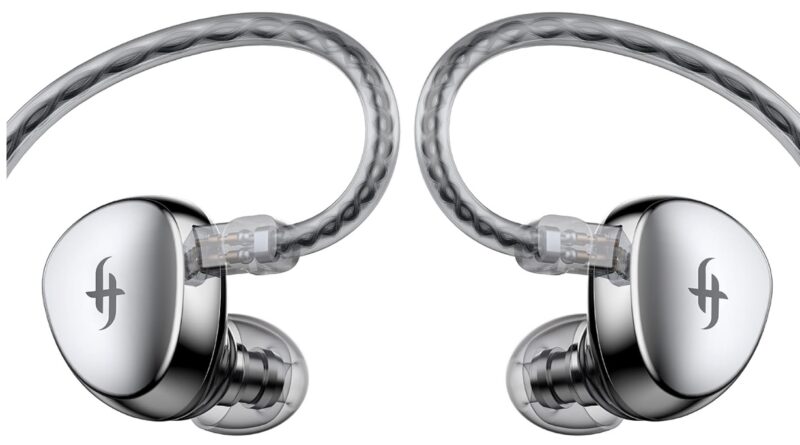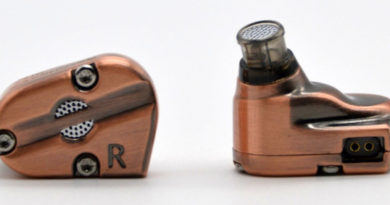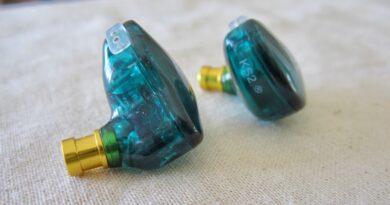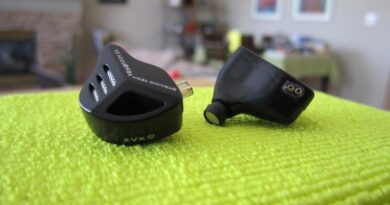Simgot EA500 Review – Budget Attempt
EA500 represent Simgot’s take to the supremely difficult <150€ market. You can find them here, They can be bought for around € 92, including Italian VAT – from multiple AE shops.
At-a-glance Card
| PROs | CONs |
| Modular nozzles offer two alternative tonalities, both calibrated with good internal coherence. | Lacking technicalities (stage depth, layering, separation) |
| Good female vocals on black nozzle. | Lean timbre / note weight. |
| Nice package for the price | Grainy trebles. |
| Comfortable to wear (for me…!). | Bass could use more texture. |
| Totally inappropriate stock tips. |
Full Device Card
Test setup and preliminary notes
Sources: Questyle QP1R & QP2R / Sony NW-A55 mrWalkman / Questyle M15 / Questyle CMA-400i – JVC Spiraldot tips – Stock cable – lossless 16-24/44.1-192 FLAC and DSD64/128 tracks.
I am not writing these articles to help manufacturers promote their products, even less I’m expecting or even accepting compensation when I do. I’m writing exclusively to share my fun – and sometimes my disappointment – about gear that I happen to buy, borrow or somehow receive for audition.
Another crucial fact to note is that I have very sided and circumscribed musical tastes: I almost exclusively listen to jazz, and even more particularly to the strains of post bop, modal, hard bop and avangarde which developed from the late ’50ies to the late ’70ies. In audio-related terms this implies that I mostly listen to musical situations featuring small or even very small groups playing acoustic instruments, on not big stages.
One of the first direct consequences of the above is that you should not expect me to provide broad information about how a certain product fairs with many different musical genres. Oppositely, you should always keep in mind that – different gear treating digital and analog sound in different ways – my evaluations may not, in full or in part, be applicable to your preferred music genre.
Another consequece is that I build my digital library by painstakingly cherrypick editions offering the least possible compression and pumped loudness, and the most extended dynamic range. This alone, by the way, makes common music streaming services pretty much useless for me, as they offer almost exclusively the polar opposite. And again by the way, quite a few of the editions in my library are monoaural.
Additionally: my library includes a significant number of unedited, very high sample rate redigitisations of vinyl or openreel tape editions, either dating back to the original day or more recently reissued under specialised labels e.g. Blue Note Tone Poet, Music Matters, Esoteric Jp, Analogue Productions, Impulse! Originals, and such. Oppositely, I could ever find and extremely small number of audible (for my preferences) SACD editions.
My source gear is correspondigly selected to grant very extended bandwidth, high reconstruction proweness, uncolored amping.
And finally, my preferred drivers (ear or headphones) are first and foremost supposed to feature solid note-body timbre, and an as magically centered compromise between fine detail, articulated texturing and microdynamics as their designers can possibly achieve.
In terms of presentation, for IEMs I prefer one in the shape of a DF curve, with some very moderate extra pushup in the midbass. Extra sub-bass enhancement is totally optional, and solely welcome if seriously well controlled. Last octave treble is also welcome from whomever is really able to turn that into further spatial drawing upgrade, all others please abstain.
Signature analysis
Tonality
EA500 feature a clear and light-noteweight timbre, and a choice of two different stock tonalities realised by installing two alternative pairs of screw-on nozzles, identified by different colored rings.
“Red ring” nozzles closely follow the Harman 2016 target aiming at balanced all-rounder tonality. “Black ring” nozzles instead cater to Simgot’s “house target” i.e. the same used for tuning their higher tier models EA1000 and EA2000. Such tuning differs from the H2016 one insofar as mid and sub-bass are more enhanced, so are high-mids and somewhat presence trebles too, with the intention to deliver an obvisouly brighter presentation delivering better detail retrieval, separation and female vocals.
In my views black ring nozzles’ intention is pretty overambitious when paired the EA500’s light timbre: the result is excessively open, etheral, uncospicuous. For my taste “red ring” nozzles pair much better with this particular driver nature, the result being still bright but more down to earth and not dramatically distant from organicity.
Sub-Bass
Sub bass is present and well calibrated vs the midbass. This applies to both nozzle cases.
Mid Bass
EA500’s mid bass has good energy but only average texture and detail, also due to not particularly tight transients. Such effect is more evident with the red nozzles, while the black nozzles offer a whiff tighter bass speed in addition to more energetic highmids, all contributing to putting the midbass a bit more at bay in the general presentation economy.
Mids
Mids are a bit recessed from the middle down, and get more upfront on their upper part. Their tonality is reasonably organic, their main limitation being note leanness. Guitars are better on red nozzles vs black nozzles. High mids do have a tendence to get shouty sometimes.
Male Vocals
Male voices on EA500 are somewhat too much in the back to take good part to the ensemble. They are quite often put on second layer either by the midbass’s lack of tightness or the high mids’ energy (the more so on black nozzles).
Female Vocals
Female singers on EA500 come across much better than male ones, especially on black nozzles. Their notes are almost always reasoably bodied and organic.
Highs
EA500’s treble is energetic and somewhat sparkly, but also perceivably grainy and sometimes shouty. Small detail resolution is present, but also quite limited. Last octave is also not partcularly well extended.
Technicalities
Soundstage
EA500 cast a reasonably sized stage, mainly on the horizontal axis however. Depth is severely lacking, height is hinted.
Imaging
Imaging is above decent: instruments are, per se, quite credibly positioned in space. A limitation is more coming from lacking separation.
Details
Detail retrieval is OK-ish on highmids and trebles, however something better might be done even at this price. Black nozzles help but at the frequent risk of scanting into sibilance and some splashyness. Mid bass detail retrieval is very basic due to lacking texture.
Instrument separation
Instrument separation and especially layering are average at best, or I should say basic, really. Again the black nozzle with his extra brightness certainly helps discerning treble instruments better by adding some more clean air between instruments, if you can accept their sonic characteristic.
Driveability
EA500 are reasonably sensitive at a generally workable impedance, and can therefor be decently driven by very many sources, including some phones or low power dongles.
Physicals
Build
Housings are nothing short of beautiful to see and manipulate. Of course there’s some problem with fingerprints like it obviously happens due to the (well executed) mirror finish. The screw-in nozzle system is well realised, and the nozzles also have an eartip retention ring.
Fit
EA500 fit me very nicely, as they strike that golden (and very personal) balance amongst size, shape, weight and surface smoothness to almost perfectly adapt to my outer ear. YMMV of course.
Comfort
I find EA500 extremely confortable once fit, I could use them for hours without any mechanical fatigue.
Isolation
Due to their shape they realise a quite nice passive isolation in my case.
Cable
Stock cable is very much in line with the market standards at this price level.
Specifications (declared)
| Housing | High density alloy metal melting and casting, mirror finish with CNC engraving |
| Driver(s) | 10 mm dual magnetic circuit 4th gen DLC composite diaphragm dynamic driver |
| Connector | 2pin 0.78mm |
| Cable | 1.2m high purity silver plated oxygen free copper cable, 3.5mm fixed single ended termination |
| Sensitivity | 123 dB/Vrms = 105 dB/mW w/red nozzles +1dB/mVrms w/black nozzles |
| Impedance | 16 Ω |
| Frequency Range | 20-20000Hz (effective) |
| Accessories and package | Three S/M/L pairs of silicon tips, two pairs of replaceable front nozzles, zip-closed rigid carry case |
| MSRP at this post time | € 92 including EU VAT |
Comparisons
Final E3000 (€86 from Amazon in EU)
Even on red ring nozzles EA500 is tuned to be a priori brighter then E3000, which of course may make the comparison not relevant. Also, with their lower sensitivity E3000 come with the non-secondary aspect of requiring a less “common” source compared to EA500 to deliver their full potential.
Once all that’s considered, E3000 are obviously better in terms of note weight, and most of all space projection, instrument separation and layering. Their trebles are less extended and energetic – in this EA500’s being better – but also always well controlled, never sibilant or splashy. Bass on E3000 has good texture, and better detail retrieval then EA500 which however has the lead on the highmid and treble details side.
Intime Sora 2 (€52 + circa € 25 refowarding costs from E-earphones)
Sora 2 offer a quite similar stock tonality compared to EA500 “red” option, with an evidently more solid, organic note weight. Mid bass is more controlled and more textured on Sora 2. Highmids and trebles are similarly sparkly and energetic, with Sora 2 not scanting into grainiess, and in general delivering more realism – thanks for sure to Intime’s exceptional ceramic tweeter.
Even more difference comes out from layering and separation, where Sora 2 excels hands down (even compared to E3000 by the way). Both drivers, on the contrary, don’t offer big wonders in terms of stage depth. Lastly, Sora 2 is not heavily marketed on western markets, so european and american fellows need some proactivity to even know about them, and buy a pair.
Maestraudio MA910S (€73 delivered to EU from Amazon.jp)
A less energetic, flatter presentation, silkier version of the Sora-2, Maestraudio MA910S are also a great alternative to EA500. For the distracted ones, Maestraudio is the other brand owned by Ozeid, the same owners of the Intime brand, and their IEMs employ the same base technologies.
Again, layering and separation on MA910S and on a higher category compared thanks to the evidently better driver and implementation. Trebles are expressive yet totally ungrainy, bass is combed, not very snappy, vocals are very balanced, the lot is ideal for a more relaxed but yet still good quality listening. Stage is equivalently mainly extended on the horizontal axis on MA910S and EA500, but MA910S have way better height, and a bit more of depth (not much). The recently released MA910SB (featuring balanced termination for a price marginally passing 100€ delivery included) are also a very interesting alternative.
Considerations & conclusions
Choosing to compete on the <150€ market is a tough challenge for anyone, and that’s even for two reasons, not one alone.
First: on technical grounds final audio literally devastated the competition on this segment when they decided to enter it already a few years ago. E1000, E2000, E3000, E4000 (for the Harman-ers) and A3000 (for bright-tuners) represent such a wide, solid, complete offering that may make many not bother looking anywhere else, and rightfully so at least in terms of result vs effort ratio.
Second: probably due to the previous fact, a very thick army of manufacturers keep on trying their skills on this playground, making it if possible even more difficult for anyone to stand out of the big contenders crowd, busy as they all are with their endless, almost daily (!) flow of “yet-another” releases.
With EA500, Simgot put in place a solid first attempt at the sub-100€ budget playground, featuring some good personality to begin with. Easy nozzle-based tonality customizability is surely a good bet, in principle, which is made even better by a correct execution as in EA500’s case. Tonal coherence, also, is well carried out. The driver itself, however, does not seem fully up to the task when compared to established similar priced staples. They will make it better, I’m sure. I’m curious to assess Simgot’s future developments !
Our generic standard disclaimer.







